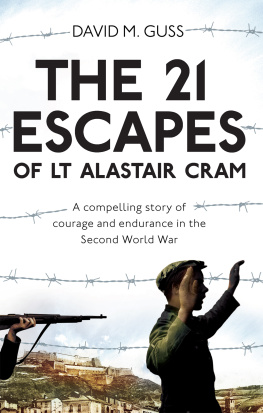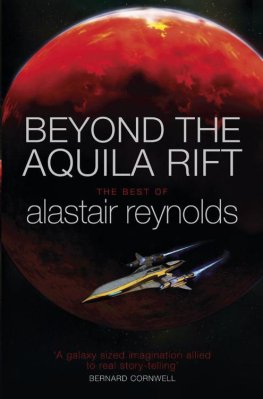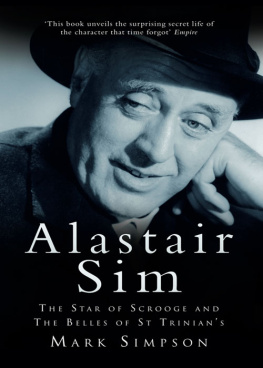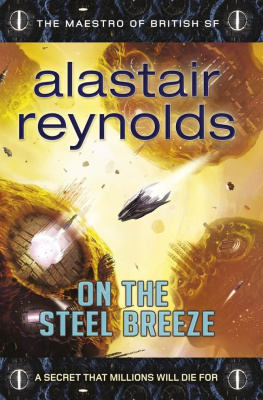THE 21
ESCAPES
OF LT ALASTAIR CRAM
A compelling story of courage and
endurance in the Second World War
DAVID M. GUSS
MACMILLAN
For Kate,
Through the wire
& home
together
Contents
List of Illustrations
I never hear the word escape
Without a quicker blood,
A sudden expectation
A flying attitude!
EMILY DICKINSON
escape as a need, as a spiritual necessity
ALASTAIR CRAM
Preface
Finding Alastair Cram
I never met Alastair Cram, and if I had, Im not sure he would have enjoyed being the subject of a book. He was such a private person, so reserved and modest, so relentlessly uninterested in talking about his many adventures. And yet he did leave a paper trail beginning with a set of journals written immediately after the war. Even these were nearly impenetrable. Written in pencil with little punctuation and words often running into one another, they were the work of a man possessed with the need to get it all down. He toyed with the idea of publishing it, wondering if it might not serve as a manual for escape. This book, he wrote in one entry, is a record of one individuals ventures outside the wire, its excuse being to represent as faithfully as possible the background of escape in Europe in this war for the adventures related here were typical of those experienced by many hundreds of officers and men of the United Nations. Of course, Alastairs experiences were anything but typical, nor did he ever try to publish it. He simply took the foolscap and cheap school notebooks hed written on and stuffed them into an envelope, never to be looked at by him again.
When I discovered them sixty years later, there were pages missing, some torn and others misfiled. Almost all of them were nearly illegible, and even with the help of an amateur cryptographer from Texas, took several years to decipher. I knew long before then, if not immediately, that his was a story I had to tell. I had known of Alastair since childhood, a legendary figure haunting the escape literature I began devouring in large quantities from the age of twelve. Its what turned me into a reader and lover of books, and eventually into a researcher as well. Such works were readily available to British children of a similar age, but I lived in America, where only a handful of the most famous titles like The Great Escape and The Wooden Horse were to be found.
A mathematics teacher with the improbable nickname of Butts came to my rescue. He had been ordering rare Lewis Carroll books from England for years and offered to add my list to his own. Today, when almost anything can be purchased over the internet with the promise of next-day delivery, its hard to remember that incomparable joy in receiving a long-anticipated package which had travelled by ship across the Atlantic. It wasnt long before I began writing to the authors, peppering them with questions and advice about other titles. None was more generous than Pat Reid, who had described his own hair-raising escape in The Colditz Story. Having grown up reading escape literature from the previous war, Reid understood my fascination and responded with long, sensitive letters, often accompanied by a book or photograph.
Then I went to college, and the Vietnam War took over, cooling my interest in anything related to the military. I wrote poetry, studied art, lived with an indigenous group in the headwaters of the Orinoco, published books on South American mythology and eventually became an anthropologist. Busy with teaching and research, it was years before I thought seriously about escape again. But on a visit to the local public library one day, I wandered over to 940.54, the Dewey Decimal Systems classification for the Second World War and escape. To my surprise there were a number of new titles Id never seen before. Unlike the first generation of books written immediately after the war, these were by men who had recently retired or simply wanted their stories recorded before they died. I pulled Tommy Calnans Free as a Running Fox off the shelf and started reading. In no time at all I was back with my old friends in the tunnels and trains with their disguises and subterfuges.
I decided to contact Pat Reid. It had been twenty-five years since we were last in touch and I wanted to let him know what had become of me and to thank him for all he had done. Unfortunately, I was too late. He had died several years earlier at the age of seventy-nine. All of this reignited my interest in escape narratives. I read a handful of the newer books and, while some were excellent, the one story I couldnt find was that of the Baron, Alastair Cram. Once referred to as the Harry Houdini of the Second World War, Alastair escaped, or at least attempted to by his own account, twenty-one times, more than any other prisoner of war. Up till then, much of what I knew about him came from a detailed MI9 report as well as George Millars Horned Pigeon and Jack Pringles Colditz Last Stop. Yet I was certain that anyone who had accomplished what Alastair had would have left some sort of record, either written or taped.
Although he had died in 1994, I believed that his widow, Isobel, might still be alive twelve years later. To my amazement, a single letter to the Scottish Mountaineering Club which Alastair first joined in 1930 was all it took. Isobel, I learned, was living in Edinburgh, and other than severe arthritis, was in relatively good health. And yes, Alastair had left a collection of journals detailing his various wartime exploits, all of which had just been transferred to the Mountaineering Clubs archives for safe keeping. I was welcome to consult them, though warned that they were impossible to read. I was also told that there was a great deal of other material that might be of interest to me. That August, my wife, Kate, and I visited Edinburgh, timing our trip to coincide with the 2007 Fringe Festival.
We adored the city and had a blast at the festival, yet what we loved most of all was Isobel. Smart and witty, with an outrageous opinion about almost everything, she welcomed us into her Stockbridge home with a warmth usually reserved for the most intimate of family members. Over the next nine years we certainly felt as though we had become that, regularly exchanging letters and calls and visiting as frequently as possible. And all the time talking about Alastair as only Isobel could. Whether it was growing up in Perth, the war years, his time as a prosecutor in Germany, the Mau Mau in Africa, or their many climbs across the globe, there was no greater guide than Isobel. Nor was there anyone more excited about finally having his story told. Alastair was a modest man, she wrote when we first met. But he does deserve credit for his deeds and it is reassuring to know he will receive it.
She told us many things about Alastair, some of which I doubted he would have shared himself. But she had always been the talkative one in their relationship, and he the solitary figure, reluctant to speak about his various adventures. He was a well-known loner, Isobel said, and I respected his silences. If he opened up and let you in, you could follow him there. But he was deeply private. Ironically, these were the same qualities Pat Reid identified as essential to the DNA of the successful escaper:













